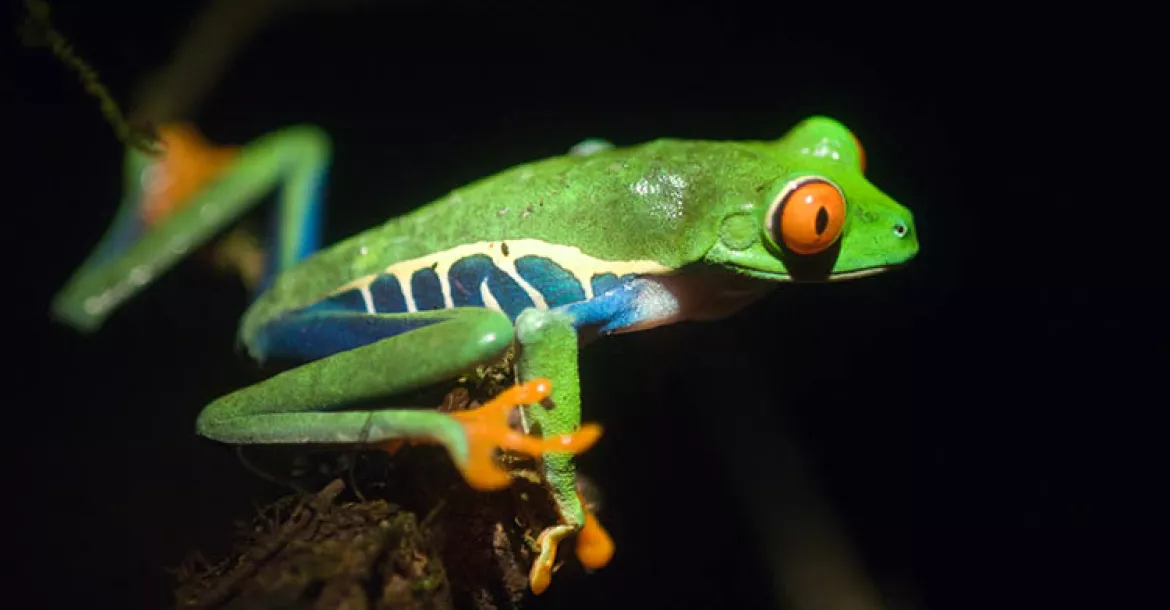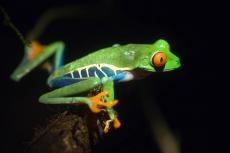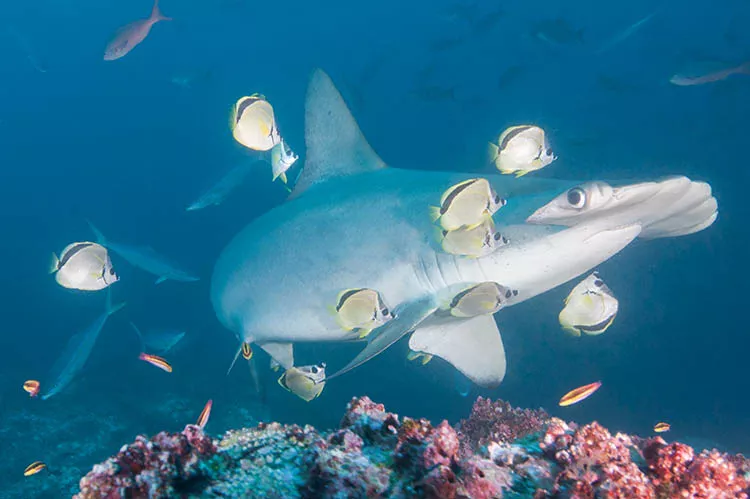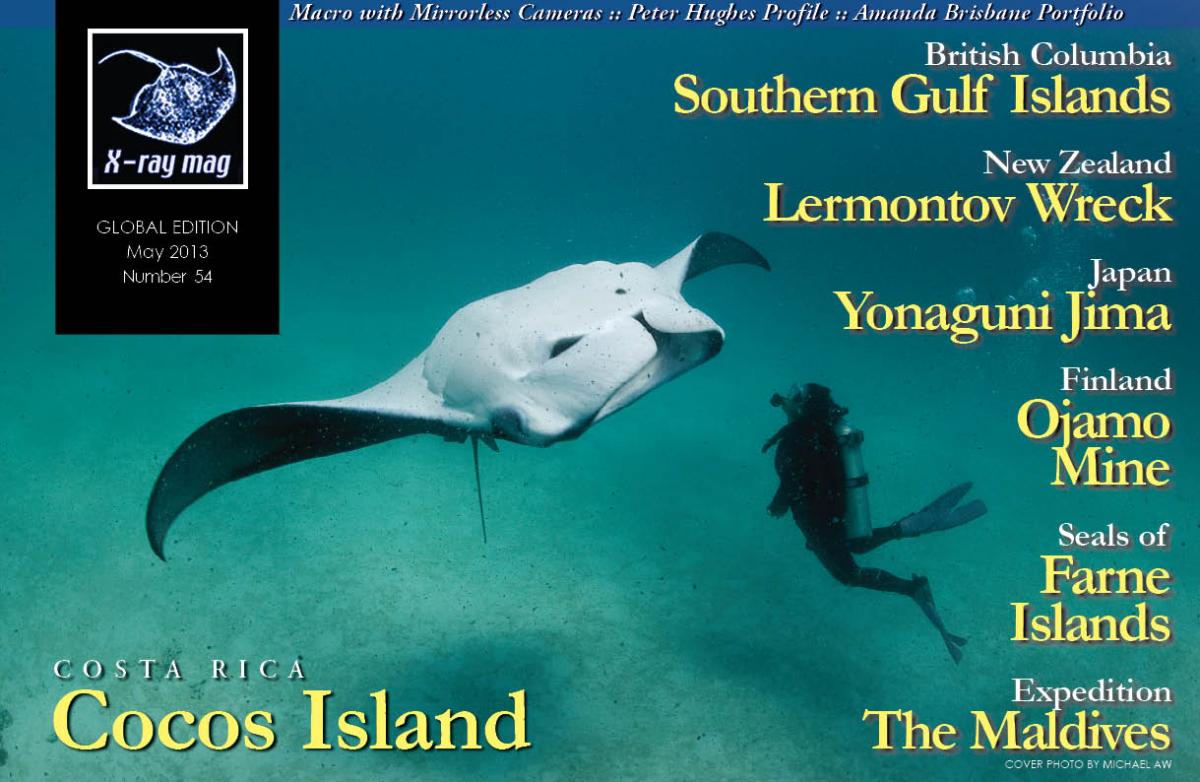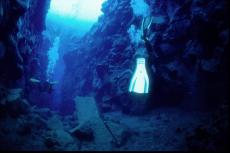Tucked behind rocks at 90 feet, my fellow divers and I were getting restless hoping for a visit from hammerheads or one of the resident tiger sharks, neither of which were cooperating. The dive master motioned for the group to follow, as he headed to another cleaning station and perhaps better luck. As I turned to make sure the videographer to my right got the signal, I saw him kicking in the opposite direction to deeper water.
Contributed by
Factfile
Matthew Meier is a professional underwater photographer and dive writer based in San Diego, California.
To see more of his work and to order photo prints, please visit: Matthewmeierphoto.com
Figuring he saw something worth pursuing, I swam blindly after him through the haze of a shimmering thermocline. Emerging out the other side onto the sandy bottom at 104 feet, I was staring at my very first tiger shark as it swam past the videographer and straight towards me.
Instinctively reversing course in shock and with a slight pucker factor, I not so gracefully stumbled backwards over some rocks and fell flat on my butt. So much for those amazing tiger shark photos I had envisioned while staring with anticipation into the blue.
Happily all was not lost, the shark turned above me, seemingly oblivious to my plight, and continued on a wide circle that would bring it around for another pass between the videographer and myself. This time I managed to keep myself upright and captured a photo of the tiger as it slowly swam past the videographer—tiger shark 1, photographer 1.
Such is the diving at Cocos Island, where periods of waiting are punctuated by heart-stopping big animal interactions.
Cocos Island
Cocos Island, or Isla del Coco as it is known locally, first became part of Costa Rica in 1832. It is uninhabited, except for a small group of national park rangers. The island became a Costa Rican national park in 1978 and was designated a World Heritage Site by UNESCO in 1997. The marine zone around Cocos Island was added to the World Heritage Site designation in 2002. Legend states that over the years, numerous pirates buried treasure on Cocos Island, though despite several extensive searches, none has been recovered.
Irregular in shape, Cocos Island has an area of approximately 9.2 square miles (23.85 squ km). Cocos is tectonic and volcanic in origin, primarily composed of basalt. The island is incredibly green and lush due to its wet climate and is covered in tropical forests and cloud forests at elevations above 500m. The cloud forest ecosystem is unique to Cocos Island and does not exist on any other island in the Eastern Pacific Ocean. Of the four mountain peaks on the island, the highest is Cerro Iglesias at 2,080 ft (634m). The mountainous landscape and abundant rainfall creates dozens of waterfalls, which drain off every side of the island.
Rich marine life
Cocos is perhaps best known for its sharks, with hundreds of schooling scalloped hammerhead and silky sharks, innumerable whitetip reef sharks, Galapagos, silvertip and now tiger sharks. It is also not uncommon to see whale sharks, manta rays and dolphins. The fish life here is incredibly abundant and the main reason these apex predators are so prevalent.
Sightings of jacks and snappers in schools that block out the sun are routine. The ample marine life surrounding Cocos Island is attracted to the nutrient-rich ocean currents that swirl around this small island 340 miles west of Costa Rica in the Eastern Pacific Ocean.
Accessible only by liveaboard dive boat, this remote island requires a 32- to 36-hour transit across potentially angry seas for the privilege of diving this holy grail of pelagic encounters. Once in the water, the currents can be fierce and more than once I had to pull myself down the mooring line just to get to a dive site.
The majority of the diving is deep, taking place between 60 to 90 feet and nitrox is recommended for extra bottom time. Rebreathers are also very useful if available and you are properly certified.
Diving at Cocos Island can be absolutely magical, but this is not a destination for beginners or the faint of heart. Divers that venture here should be comfortable with their buoyancy in blue water and capable of holding onto rocks at depth so as not to be blown away by the strong currents.
Cleaning stations exist at several of the dive sites and are a major attraction for viewing sharks. Successful interactions at cleaning stations require a collaborative group effort. Divers need to hide amongst the rocks, doing their best to control their breathing and wait patiently for the sharks to come in close to be cleaned by the lingering angel and barberfish.
Most cleaning stations are at 90 to 100 feet, limiting the amount of dive time for all the pieces to fall into place, and it only takes one diver swimming up in the water column or worse, swimming through the cleaning station to keep the sharks away.
I experienced idyllic conditions at Alcyone dive site while watching a scalloped hammerhead approach out of the blue and swim directly towards me. As I held my collective breath, at least a dozen barberfish swooped in to clean off parasites and bits of dead skin. Just as the hammerhead began to turn away, I managed to capture a photo documenting this classic cleaning station behavior.
Not all diving at Cocos Island involves lying in wait at cleaning stations. There are several underwater swim-throughs filled with fish, marbled rays and whitetip reef sharks to explore.
Rocky reefs are teaming with life including spiny lobster, octopus, urchins, sea stars and numerous reef fish. Sea turtles cruise past in the blue water, and huge schools of fish appear without warning, often swimming circles around you or swirling into a gigantic underwater tornado. If you are lucky, you may also find an endemic Coco’s batfish or orange Commerson’s frogfish.
Whitetip reef sharks
For the truly adventurous, a night dive with the whitetip reef sharks at Manuelita dive site is a must. Dropping into the water after the setting sun, I switched on my dive light and tried to remember the dive master’s instructions. We were to stay as a group, using our flashlights in unison, highlighting a particular reef fish in hopes that we attracted the larger black jack fish to feed.
Black jacks are efficient hunters, fast and maneuverable, and the whitetip reef sharks follow them, as they hunt at night in search of food. It turns out the sharks are not very good at hunting on their own, but they have more success searching for food when they rush in by the dozens once a black jack has crunched down on a fish.
The action takes place mere inches above the coral reef, and it is truly a sight to behold, as dozens of sharks pack hunt directly beneath you. I was tempted to get down on their level and experience the rush, as they swarm past, but we had been warned about becoming prey ourselves, and so I stayed slightly above the fray.
From experience, I have learned that it is also prudent to look behind yourself once in a while, as you float along in total darkness, just in case one of the larger species of sharks, which you were so eager to see during the day, comes to investigate the commotion at night.
DeepSee submarine.
Another exhilarating way to see the undersea world at Cocos is in a submarine. Locked securely inside a four-inch thick acrylic sphere, I took the plunge and embarked on one of the most amazing experiences of my trip—a dive down to 1,000 feet on board the DeepSee submarine.
As we dipped below the surface, the confines of the sub melted away, and it was as if I was now part of my ocean surroundings. The optically corrected sphere had a refractive index that nearly matched the water, and it disappeared from view once fully submerged. As the submarine descended, I lost all perspective of depth in the blue water and was left simply to marvel at the 360-degree views of the pelagic passers by that wandered over for a curious look.
The DeepSee submarine holds two passengers and a pilot and is capable of diving to depths of 1,500 feet (450m). Created by Avi Klapfer, the founder of the Undersea Hunter Fleet, and Steve Drogin, real estate developer and passionate underwater photographer, DeepSee required three years of design and development in order for their vision to become reality.
Manufactured in San Diego, the submarine first began diving at Cocos Island in 2006. DeepSee is fully outfitted for scientific exploration with an articulated, manipulator arm capable of sample collection and instrument retrieval. It is also outfitted with an external HD video camera, digital still cameras and an assortment of 8 HID lights. In addition, passengers are able to use their own still and video cameras from inside the submarine.
The adventure started with a pre-dive briefing covering the functions of the submarine, safety procedures and the dive parameters. Next, passengers were outfitted with an official cotton jumpsuit (imagine a cooler version of The Life Aquatic uniform, but without the hats) and comfy socks to protect the bottom half of the sphere from scratches. Then it was a short walk to the back of the mother ship, Argo, and a simple step into the cockpit while DeepSee floated on the surface in her protective U-shaped cutout of the hull.
The submarine is unique in that it can operate as a boat on the surface and a sub underneath, but for longer surface journeys the support boat, TopSee, tows DeepSee out to the intended dive site. A second pilot on board TopSee helps to guide the submarine during the dive and communications are maintained between the surface and the sub at all times.
As we reached the sea floor nearly 600 feet down, the precise hover and maneuvering capabilities of DeepSee were put on full display. Eight electric thrusters, which move the submarine up and down, forward and back and horizontally left and right, controlled the propulsion.
Our pilot guided us over the sandy bottom to the edge of a sheer, vertical drop called The Wall. Here several mobula rays, feeding in the deep ocean currents, soared above us, as we peered down into the abyss. Breaking our gaze, DeepSee deftly pivoted to face the wall, and we began our exploration down to 1,000 feet.
No sunlight reaches these depths, and the creatures down here have all adapted to living in total darkness. Hiding in the crevices, we saw colorful anthias, several species of crabs, groupers slowly hunting in our lights and the bizarre looking jellynose fish. Sadly, we did not get to see a prickly shark. This deep-water species is often encountered on The Wall at depths below 800 feet.
As our journey back to the surface began, we were treated to a school of tuna swimming overhead, followed by several Galapagos sharks in silhouette against the faint daylight above. It was a once-in-a-lifetime opportunity, and I was sad to see it come to an end. Fortunately, there were many more epic diving adventures around Cocos Island, and I looked forward to getting back in the water.
Island life
Cocos Island is covered in lush greenery, tropical forests, mountains and waterfalls. It is perhaps the most beautifully, rugged landscape I have ever seen.
Park rangers give presentations on the island’s history, ecosystem, topography, World Heritage Site status and their efforts to protect its wildlife both above and below the surface. Land tours are possible with coordination by the rangers and offer a great chance to explore this tropical oasis.
The routine while on the liveaboard boat includes three to four dives daily, with meals and snacks in between. Surface intervals are spent prepping camera gear, exploring the island’s coastline by skiff when available and relaxing on deck. Bring a good book and take advantage of the opportunity to make some new friends.
Costa Rica
I would highly recommend including a mainland Costa Rican side trip to your Cocos Island adventure. There is something for any outdoor enthusiast, and the Costa Rican people are incredibly warm and friendly.
Costa Rica offers a wide array of tourist activities, and the country has a diverse geography including mountains, volcanoes, tropical rain forests, cloud forests and beaches. The Pacific coastline offers world-class surfing and scuba diving, while the Caribbean coast boasts gorgeous tropical beaches.
Costa Rica is world-renowned for its birdwatching and butterflies, including numerous species of hummingbirds. Walking tours are available in both the tropical rain and cloud forests. For the more adventurous, there are canopy tours and ziplining excursions. The areas around the volcanoes offer secluded resorts, yoga retreats and mineral hot springs. Whatever you choose, your Cocos Island experience will be enriched with the extra time spent.
Save me a spot at the cleaning station
I now understand why people revisit Cocos Island again and again. The big animal encounters are awe-inspiring, and the rush one feels underwater is addictive.
I can still picture the fleeting glimpse I had on my last day of diving at Dirty Rock, as the dozens of hammerheads in silhouette overhead faded into the blue long before I could even bring the camera up to my eye, or the anticipation I felt on the skiff, as we scrambled to get back to the mother ship amidst cries of “Whale shark! Whale shark!” over the radio, only to arrive just as the rest of the divers and crew members climbed back out of the water, stating that we had just missed her.
I know that I will return to Cocos Island one day and hope that you too get the chance to experience this magical place. ■
The author extends special thanks to the Undersea Hunter Group (Underseahunter.com), the crew of the Argo, the crew of the DeepSee submarine and DivEncounters Alliance (Divencounters.com), and Blue Abyss Photo (Blueabyssphoto.com).

